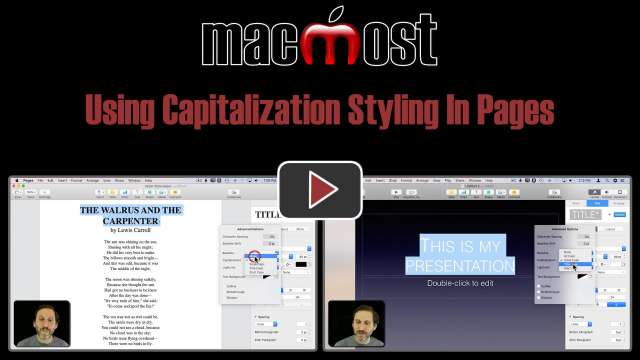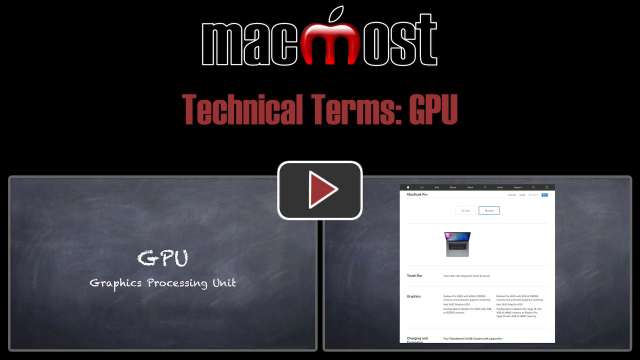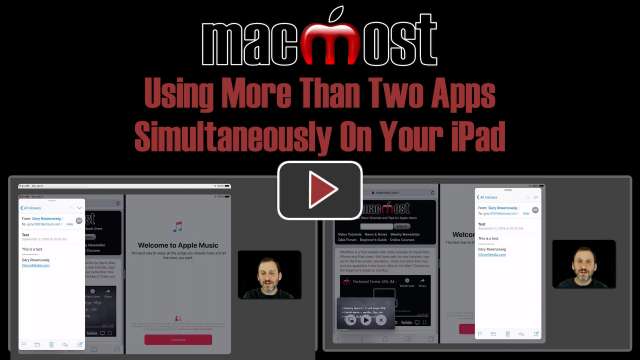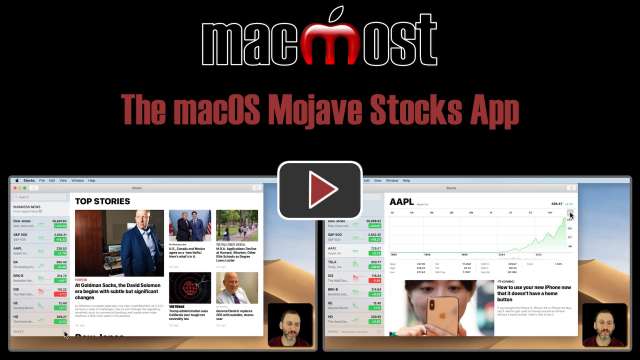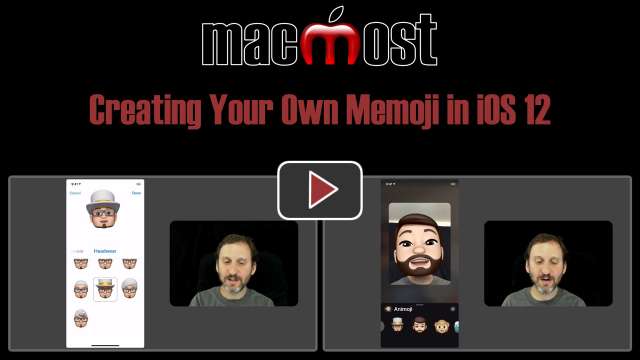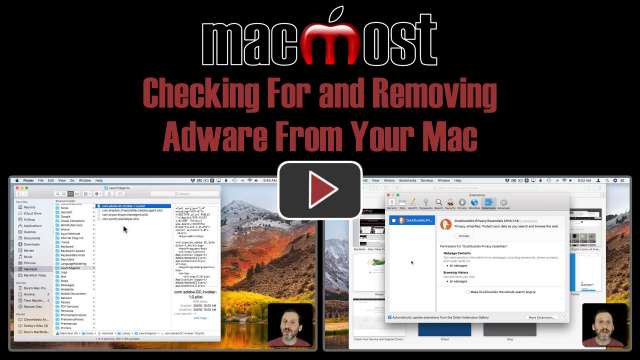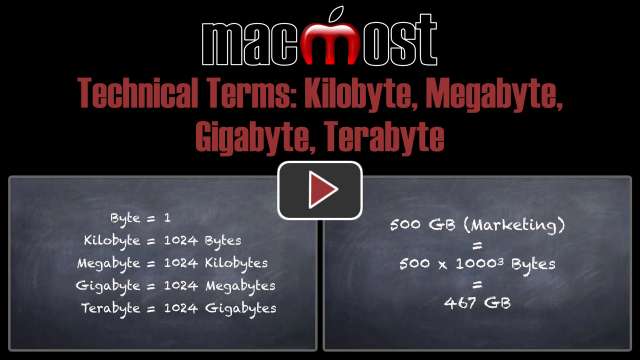For many of the last ten years the week of MacWorld Expo has been the biggest news week of the year for Apple fans. This year might not be as exciting as 2006 with the announcement of the iPhone, but we had some good news nonetheless.
Both iLife and iWork and all apps in them are being updated. It looks like iMovie 09 will get some more professional features, and iPhoto will get some new organizational tools. You can read all about the announcements in our special MacMost keynote blog post.
Apple also announced the new 17-Inch MacBook Pro with similar features to the 15-Inch released a few months ago. One interesting new feature in the 17-Inch is an 8-hour battery that uses some new technology and sits inside the case rather that in a removable compartment.
Another announcement is that the iTunes music store will finally be switching to a DRM-free model. All songs will be DRM-free by the end of the quarter. In addition, you’ll be able to upgrade your old music to the DRM-free versions. Plus, the $0.99 pricing will be gone, replaced by $0.69, $0.99 and $1.29 prices. Looks like a lot of the older tracks will be at the lower price, making them more competitive with other MP3 services.
Of course there will be a lot more news this week from companies other than Apple. Many Mac and iPhone-related companies release software and hardware at the MacWorld Expo. Check the MacMost.com Top Apple News page for some of the biggest stories. Also check the All Apple News page to dig deeper and see just about every news story and press release issued this week.
The MacWorld Expo keynote address is being given by Philip Schiller, Apple senior VP for Marketing. Apple CEO Steve Jobs has given the keynote for the last 10 years, but is recovering from an illness.
Schiller starts by mentioning how 3.4 million people visit Apple stores every week, and compares it to 100 MacWorld Expos every week. This fits with one of Apple’s reasons why they are not going to do any more MacWorld events — the Apple stores make it unnecessary.
He says that he will focus on the Mac in this keynote. There will be three Mac-related announcements. The first is iLife 09.
iPhoto 09 will include organization by faces. Facial recognition technology will allow you to tag your photos according to who is in them. You can also organize by places, using GPS information and a map with pinpoints you can place. Map is from Google Maps and you can zoom in and use satellite views too. You can also specify your own locations for photos without GPS information.
The new iPhoto will also let you upload directly to Flickr and Facebook. Tagging information from these services will sync back to your iPhoto library. The maps can also be used in new iPhoto book themes.
There will also be new slide show functionality in iPhoto 09, with themed slide show layouts. These slide shows use 3D effects and face detection to zoom in on individuals. Slide shows can then be exported to iPod or iPhone.
iMovie 09 will feature a precision editor and advanced drag-and-drop. There will also be advanced themes and animated travel maps. You can apply interesting effects as well, including things like image stabilization, aged film and cartoon effects.
GarageBand 09 will have a whole new “Learn to Play” feature: guitar and piano lessons from instructors and well-known artists like Sting, John Fogerty, Norah Jones and Sarah McLachlan. The lessons will cost $5 a piece. Looks like you will be able to slow down and play along with the other tracks.
iDVD and iWeb will also get updates. iLife 09 will cost $79 with a $99 family pack. It will be released later this month.
iWork is also up for a new version. Keynote will get new transitions and themes. There will also be an iPhone app that lets you control your Keynote presentation from the iPhone. You’ll be able to see the slides on your iPhone, including a preview of the next slide. Swipe to move slides.
Pages will also get an update, with a full screen mode, outline view, new templates, mail merge with a Numbers spreadsheet, and the ability to type math equations. A Numbers update too with table categories, more functions and forumlas features, more charts and templates.
iWork 09 will be $79 or $99 for a family pack. But it will only cost $49 if you buy it with a new Mac. Shipping today. There will also be a box with Mac OS X, iLife and iWork for $169.
Apple is also going into beta on a project called iWork.com. This will be a online sharing space for iWork applications. You can also annotate and edit document online. iWork.com launches today. It will be free during the beta, but eventually a pay service.
Third announcement: A new 17-inch MacBook Pro. It will be the lightest 17-inch laptop. The screen will be 1920×1200. It will be less than 1 inch thin in a uniform body like the 15-inch MacBook Pro. Also: 3 USB ports, Firewire 800, glass track pad, anti-glare screen as an option. The processor is a 2.66GHz dual-core. It can take up to 8GB of memory, and comes with a GeForce 9400m video card. You can also get a 256GB solid state drive as an option. The battery life is 8 hours, with 1,000 charges. $2,799 with 320GB drive, 4GB memory. It will ship later in January.
One more announcement is new pricing and features in iTunes. Songs will be priced at either $0.69, $0.99 or $1.29. Starting today more than 8 million songs will be available in iTunes plus, which is DRM-free. By the end of the quarter, all 10 million songs will be DRM-free in 256 kbps with aac encoding.
You will also be able to purchase music over the 3G network on your iPhone, starting today. The songs will sync back to your computer.
As expected, this week’s news has been dominated by MacWord Expo rumors. Coming on strong as rumors of an update to the Mac Mini, including a new black and aluminum look and updates that match the video systems in the new MacBooks. This rumor actually makes sense and would fit the level of expectation connected to the keynote given, not by Steve Jobs, but by Apple VP Phil Schiller. A new Mini, along with Snow Leopard details would make sense.
There is also a new rumor floating around that iWork will be taken online as a set of Web-based apps and part of MobileMe. This seems far more unlikely, as the iWork apps have a lot of functionality that would be difficult to make into Web-based applications. Plus, Apple’s own iWeb, which would seem to be something that should have been Web-based, isn’t.
Outside of the rumors, the iPhone began selling this week at Walmart, giving Apple another 5,000 locations or so where you can buy the phone. Read my blog post about this strategy. Plus, AT&T began selling refurbished iPhones for only $99.
Buy an iPhone at Walmart, save $2!
$2? What’s the big deal? Why is everyone so excited about the iPhone being at Walmart?
After all, it has been available at 250 Apple Stores in the U.S. since mid 2007. And it can be found at even more AT&T stores. But Walmart does add one very interesting aspect — besides the $2.
Walmart grew to become the nation’s largest retailer by starting outside of cities. Instead, Sam Walton but his stores in the thousands of small towns and cities across the country. They went where others wouldn’t go. Even today, when there are plenty of Walmarts in the big cities too, Walmart can be found in just about every small city and town in the U.S.
So, for Apple and the iPhone, this means that they can now reach places that the Apple Store and AT&T can’t. For instance, in my home state of Colorado, there are six Apple Stores. Five are in the Denver/Boulder area and one in Colorado Springs. But go west across the mountains and you get to Grand Junction where there you are a four hour drive from the nearest Apple Store and you were previously left with only one choice: a single AT&T store that sells the iPhone (at least according to the AT&T site). But you have three Walmarts.
Now go south to Durango, Colorado. A great place. But no Apple Store, no AT&T store. But 2 Walmarts.
You get the idea. With 5,700+ Walmarts Apple has significantly extended its iPhone sales reach.
Walmart has been known to make or break small manufacturing companies by simply deciding whether or not to stock their product. Apple’s OK with or without Walmart, but with this deal they move one step closer to dominating the smart phone market.
It is finally time for the MacWorld rumors to start flying. We’re only two weeks away from the big show now, but it no longer seems like a big show with Steve Jobs sitting it out. Expectations for Apple announcements are low.
The most outrageous rumors have to do with Apple announcing a new mini-laptop netbook or an iPhone Nano. Other rumors tell of new iMacs or a new Mac Mini. But more sensible rumors say that Apple VP Phil Schiller will simply talk about Snow Leopard during his keynote.
Outside of the rumors, there is little news. In Britain, Mac users finally get the BBC iPlayer on Macs. This application is used to view BBC programs on computers and the BBC received criticism for originally making it Windows-only.
The MobileMe service seems to be receiving continuous attention from the developers as Mac OS X 10.5.6 introduced some speed improvements for syncing data — and the Web applications in MobileMe also received updates in the past week.
Some rumors are going around that Apple will release a netbook next year. But there are many reasons why this simply won’t happen. The rumors are the result of wishful thinking by people who love the concept of a netbook and would naturally like to see one from Apple.
A netbook is a small ultra-portable laptop that is very inexpensive. A typical one costs less than $500 and weighs less than 3 pounds. They have very small screens and slow, energy-efficient processors. They are called netbooks because they are primarily for email and Web surfing, not for processor-intensive applications or development.
I love them too, and wish Apple would come out with one. But here is why they probably aren’t even considering it.
So don’t hold your breath for a Mac netbook. I’m sure Apple has a iPod Touch “plus” or “pro” as a prototype somewhere, and maybe that will emerge one day. But I think the only budget Mac that will be available for a long time will be the Mini. Look for an update to that in January.
A quick look at eleven iPhone games, including Fieldrunners, Pac-Man, SinkSub, Touch Physics, Idle Hands, Ocarina and more.
Big news this week as Apple dropped a bomb on the Mac community by announcing that there will not be any Steve Jobs keynote at this year’s MacWorld Expo. Even more shocking was the fact that Apple won’t be at next year’s MacWorld Expo at all.
Not only is this the end of an era for Apple and our community, but it probably means there aren’t going to be any big announcements in January, either. See this blog post about it.
The Mac OS X team was busy this week with the release of Mac OS 10.5.6. This consisted of lots of bug fixes, and much faster syncing for MobileMe users. There were also some security patches involved, so make sure you run Software Update.
It’s also time for last-minute holiday shopping. You can get some good gift suggestions for Mac and iPhone users in our latest gift guide.
We’ve also released a new set of iPhone ringtones this week, featuring Los Angeles artist and podcaster Anji Bee.
Check out some gift ideas for Mac and iPhone users that cost less than $50: headphones, headsets, cooling pads, media readers and even a game.
The MacWorld Expo will go on next month as usual, but without Steve Jobs. Instead Apple Senior VP Phil Schiller will make an address. I’m sure nothing ground-breaking will be announced.
In addition, Apple said this is the last time they will participate in the MacWorld Expo, which is, after all, an independent event, not something Apple owns.
Apple stated today:
…trade shows have become a very minor part of how Apple reaches its customers. The increasing popularity of Apple’s Retail Stores, which more than 3.5 million people visit every week, and the Apple.com website enable Apple to directly reach more than a hundred million customers around the world in innovative new ways.
So why this change? I think it is simply that Jobs and Apple are growing tired of having to conform to an annual schedule of producing huge announcements. Instead, they’ve been working hard to prove that they can have their own “MacWorld keynote” whenever they want, as Jobs did several times over the last few years with special events held at the Apple campus.
This is probably a good year to start, too, as the lack of rumors and the recent refresh of most of the Apple Mac line and iPhones makes it obvious that Apple didn’t have anything to announce. They can’t have Jobs going up there to announce “Snow Leopard is still coming” or a new video adapter cable.
I think what we’ll see from now on is periodic events held at Apple that are also broadcast to Apple stores worldwide.
Oh, and then there will still be the WWDC — the Apple Worldwide Developers Conference. But that is something Apple has complete control of. They’ve shifted the dates around for that many times, and can even be expected to skip a year here or there, as Microsoft has done with their comparable conference.
So this is probably all about Apple taking even more control over their message. Not just what that message is, but when it arrives as well.

